Pathologists spend hours examining slides, where every detail matters. The shift to digital workflows means that the monitor is now the microscope. An inadequate display can cause eye strain and diagnostic uncertainty.
The best displays for digital pathology review are medical-grade monitors with high resolution (at least 4MP, ideally 5MP to 8MP), exceptional color accuracy (10-bit depth, sRGB coverage), and a large screen size (32 inches or greater) for efficient workflow.
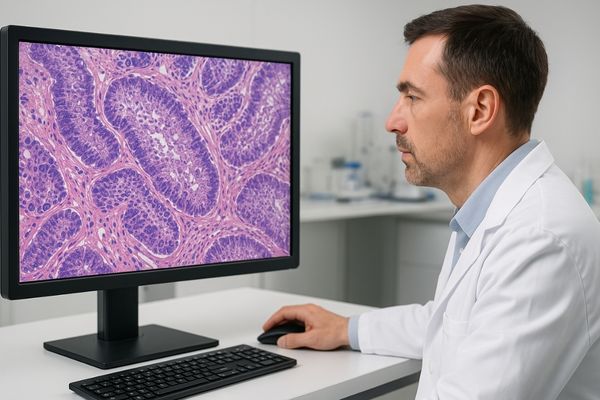
The transition from traditional glass slides to digital whole slide imaging (WSI)1 has revolutionized the field of pathology. This technology allows for easier collaboration, archival, and analysis. However, it also places new and intense demands on the displays used for review. A consumer-grade monitor is simply not built for the rigor and precision required for making a diagnosis from a digital image. The right display is a critical instrument that directly impacts diagnostic confidence and efficiency. I will explore the unique visual requirements of digital pathology. We will discuss resolution2, color accuracy3, and ergonomics. This will help you understand what to look for in a display that can meet these challenges.
What visual demands are unique to digital pathology review?
Digital pathology is more than just viewing a static image. It is an active process of navigation and analysis. A standard office monitor can cause eye fatigue and frustration during this dynamic work.
Digital pathology uniquely demands exceptional clarity for constant zooming and panning across massive whole slide images. It also requires precise color fidelity to interpret stains correctly and ergonomic features like stable brightness and anti-glare to support long hours of focused review.
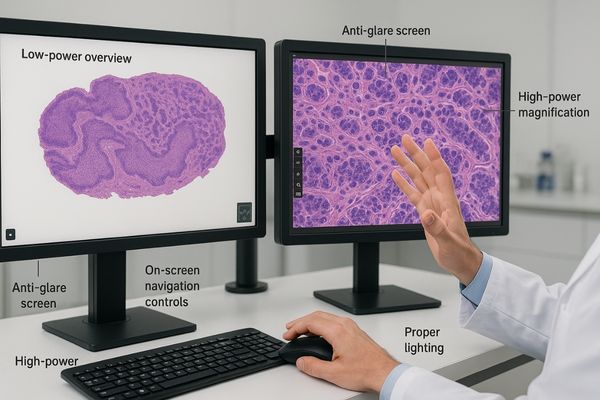
Unlike reviewing a static X-ray, digital pathology involves interacting with a massive dataset known as a whole slide image4, or WSI. These files can be several gigabytes in size. The pathologist must navigate this vast digital landscape, seamlessly panning across the slide and zooming in from a low-power overview to a high-power view of individual cells. This workflow creates several specific visual demands. First, the display must have a fast pixel response time to prevent motion blur or ghosting as the pathologist pans across the image. Any smearing can be disorienting and mask subtle details. Second, brightness and color must be perfectly uniform across the entire screen. Any hot spots or dim corners could lead to misinterpretation of tissue viewed in that area. Third, since pathologists spend many hours a day looking at these screens, visual comfort5 is paramount. Features like flicker-free backlights and effective anti-glare coatings are essential to reduce eye strain and fatigue. The MD45C – Dual-screen Diagnostic Monitor (Single Panel) supports this workflow by allowing a pathologist to view a WSI alongside patient data or a comparative slide on a single, seamless surface.
How much resolution is required for accurate pathology diagnosis?
You might wonder if your current monitor has enough detail. Using a low-resolution screen is like looking through an out-of-focus microscope. It can hide the very cellular details you need to see for a diagnosis.
A minimum resolution of 4MP (2560×1440) is recommended for digital pathology. For primary diagnosis or complex cases, 5MP to 8MP displays are superior because they show more detail at once, reducing the need for excessive zooming and increasing diagnostic speed and confidence.
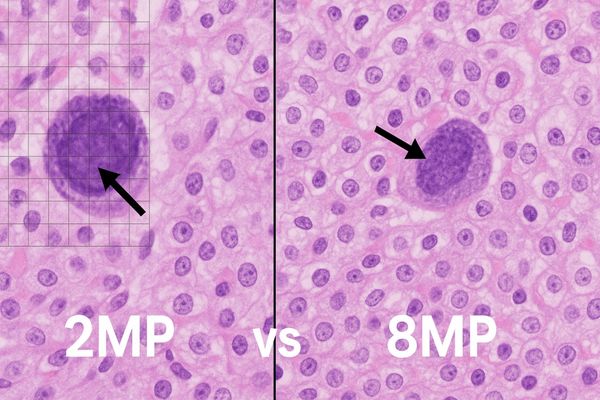
Resolution refers to the number of pixels a screen uses to create an image. In digital pathology, more pixels translate directly to more detail. A higher resolution6 allows a pathologist to see a larger field of view with diagnostic-level clarity. This is a significant workflow advantage. Instead of constantly zooming in to identify cellular structures and then zooming out to see their context, a high-resolution monitor allows the user to see both simultaneously. For example, on an 8MP display, a pathologist can assess the overall tissue architecture while still being able to distinguish the nuclear morphology of individual cells. This capability drastically reduces the amount of panning and zooming required to review a slide, which saves time and reduces mental fatigue. While 4MP is a functional entry point, moving to a higher resolution like 5MP or more is a direct investment in diagnostic quality7 and efficiency. It minimizes the risk of missing small foci of disease that might be less apparent on a lower-resolution screen. Our MD51CHY – 34" 5MP Diagnostic Monitor for X-ray Imaging provides the high resolution and panoramic view that is also perfectly suited for detailed pathological review
Recommended Resolution for Digital Pathology
| Resolution | Pixel Dimensions | Best Use Case |
|---|---|---|
| 2MP (FHD) | 1920 x 1080 | Not recommended for primary diagnosis; for lab info systems. |
| 4MP (QHD) | 2560 x 1440 | Minimum recommended for routine review. |
| 5MP | 2560 x 2048 | Excellent for primary diagnosis; good detail. |
| 8MP (4K) | 3840 x 2160 | Ideal for complex cases and high-volume labs. |
| 12MP+ | 4200 x 2800+ | Premier choice for multi-slide comparison and research. |
Do color accuracy and wide gamut significantly impact pathology work?
The colors of tissue stains look different on your screen compared to a glass slide. This inconsistency can create doubt. Misinterpreting the subtle shades of a stain could lead to an incorrect conclusion.
Yes, color accuracy is critical. It ensures that histological stains like H&E are reproduced faithfully, which is essential for accurate interpretation. A wide color gamut and 10-bit color depth reveal subtle variations in hue and saturation that are often diagnostically significant.
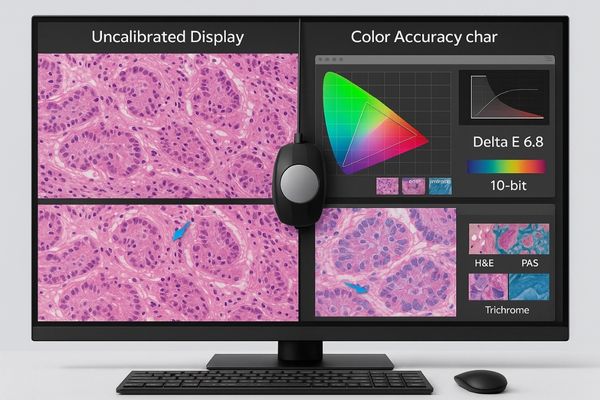
The practice of pathology is deeply rooted in the interpretation of color. Stains like Hematoxylin and Eosin (H&E)8 use specific colors to highlight different cellular components—the nucleus in blue and the cytoplasm in pink. The exact hue, saturation, and intensity of these colors provide vital information about the tissue’s health and state. A standard office monitor, designed for text and graphics, cannot reproduce these colors with the required precision. A medical-grade pathology display9 must have a wide color gamut, covering at least 100% of the sRGB space, to show the full range of colors present in the stains. It must also support 10-bit color. An 8-bit monitor can display 16.7 million colors, but a 10-bit monitor can display over a billion. This vast increase allows the display to render extremely subtle gradients and shades, for instance, distinguishing between different shades of pink in the cytoplasm that could indicate cellular abnormalities. To maintain this performance, hardware calibration10 is essential to correct for color drift over time. Our MD50C – 5MP Color Mammography Monitor is built for this level of precision, offering exceptional color fidelity that translates directly to diagnostic confidence in pathology.
How do screen size and pixel density affect slide navigation?
You find yourself constantly panning and zooming on a digital slide, trying to build a mental map. This constant movement is inefficient. It slows down your workflow and contributes to fatigue and frustration.
A large screen (32 inches or more) lets a pathologist see a larger area of the whole slide image at once, which reduces panning. High pixel density (PPI) keeps the image sharp at all zoom levels, making navigation faster and more intuitive.
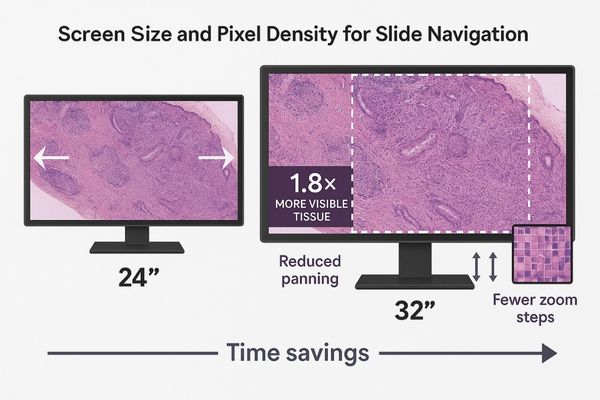
Screen size and pixel density11 work together to improve the digital pathology workflow. A larger screen provides more physical real estate to display the WSI. Think of it as having a larger desktop to work on. This expanded view provides crucial context, allowing the pathologist to see the relationship between different tissue structures without having to pan around constantly. It helps in quickly identifying regions of interest for closer inspection. However, a large screen is only useful if it has a high resolution12 to match. This relationship is measured in pixels per inch (PPI). A high PPI means the pixels are packed tightly together, creating a sharper, more detailed image that looks more like a view through a real microscope. With high pixel density, a pathologist can work from a more zoomed-out perspective and still identify abnormal cell clusters, which is much more efficient than scanning the entire slide at maximum zoom. This combination of a large viewing area13 and a crisp, detailed image fundamentally changes the navigation experience from a frustrating hunt to an efficient examination. The 8MP Diagnostic Display – 8MP Multi-modality Diagnostic Monitor embodies this principle, offering a large 4K canvas for effortless navigation.
Impact of Screen Size on Viewable Area (at same magnification)
| Screen Size | Relative Viewable Area | Workflow Impact |
|---|---|---|
| 24" | 1.0x (Baseline) | Significant panning and zooming required. |
| 27" | ~1.3x | Better context, moderate reduction in panning. |
| 32" | ~1.8x | Excellent overview, significantly less panning. |
Which Reshin displays are designed for digital pathology use?
You understand the key features needed in a pathology display. Now you need to find a specific model that brings them all together. Choosing the wrong medical monitor is an expensive error with clinical impact.
Reshin offers a dedicated line of diagnostic displays ideal for digital pathology. These include our MD32C (3MP), MD50C (5MP Color), and the premier MD120C (12MP) monitor. Each is designed with the high resolution, calibrated color, and ergonomic features needed for a confident workflow.
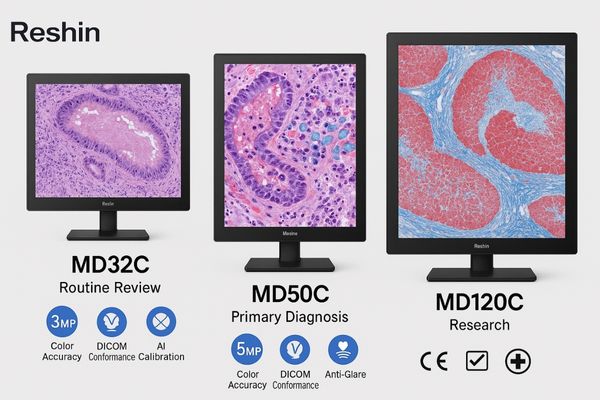
We have developed a range of diagnostic monitors specifically to address the challenges of digital pathology. Our displays are built to function as primary diagnostic tools. They combine high resolution, superior color performance, and user-centric design. Features like DICOM Part 14 conformance14 ensure a globally recognized standard of image quality and consistency, which is invaluable for sharing and collaboration. We incorporate factory calibration and provide tools for ongoing quality control to ensure that the color and grayscale you see on day one remain accurate for years. We also focus heavily on ergonomics15 to support the well-being of pathologists. Our monitors feature anti-glare coatings to minimize distracting reflections, and flicker-free and low-blue-light technologies to reduce eye strain during long review sessions. For the most demanding pathology environments, we offer the MD120C – 12MP High-Precision Diagnostic Monitor with AI Calibration16. Its massive resolution allows for viewing an entire WSI with unprecedented detail or comparing multiple slides side-by-side without compromise, while its AI-powered calibration ensures peak performance with minimal effort.
Conclusion
Choosing a medical-grade monitor with high resolution, precise color, and a large screen is not an option for digital pathology. It is essential for diagnostic accuracy, workflow efficiency, and pathologist well-being. To upgrade your pathology workflow with purpose-built diagnostic displays, contact Reshin at martin@reshinmonitors.com.
-
Explore this link to understand how WSI is transforming pathology with enhanced collaboration and analysis capabilities. ↩
-
Discover the significance of resolution in digital pathology and its role in ensuring precise diagnoses and efficient workflows. ↩
-
Learn why color accuracy is crucial for accurate diagnoses and how it affects the quality of digital pathology images. ↩
-
Understanding whole slide images is crucial for grasping the complexities of digital pathology and its applications. ↩
-
Exploring visual comfort can reveal how it affects pathologists’ efficiency and accuracy in diagnosing through digital images. ↩
-
Exploring this resource will provide insights into how higher resolution monitors enhance diagnostic accuracy and efficiency in pathology. ↩
-
This link will help you understand the critical role of display resolution in ensuring high diagnostic quality in medical imaging. ↩
-
Understanding H&E staining is crucial for interpreting tissue health and diagnosing diseases accurately. Explore this link for in-depth insights. ↩
-
A medical-grade display is vital for accurate diagnostics. Discover the essential features that ensure precision in pathology imaging. ↩
-
Hardware calibration is key to maintaining color accuracy over time, which is critical in medical diagnostics. Learn more about its importance here. ↩
-
Understanding pixel density is crucial for optimizing image quality in digital pathology, enhancing diagnostic accuracy. ↩
-
Exploring high resolution’s role can reveal how it improves image clarity and diagnostic efficiency in pathology. ↩
-
A large viewing area enhances the ability to analyze complex tissue structures, making diagnostics more effective. ↩
-
Understanding DICOM Part 14 conformance is crucial for ensuring high-quality image standards in digital pathology. Explore this link for in-depth insights. ↩
-
Ergonomics plays a vital role in the design of diagnostic monitors, enhancing comfort and efficiency for pathologists. Discover more about its importance here. ↩
-
AI Calibration can significantly enhance monitor performance and ease of use, making it a game-changer in diagnostic imaging. Learn more about its advantages here. ↩

